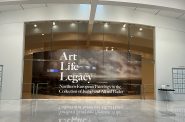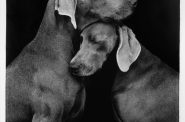Chuck Close’s “Nancy”
Close's monumental painting tells the whole truth about Nancy.

Chuck Close (American, b. 1940) Nancy, 1968 Acrylic on canvas 108 3/8 x 82 1/4 in. (275.27 x 208.92 cm) Gift of Herbert H. Kohl Charities, Inc. M1983.207 Photo credit Larry Sanders © Chuck Close/ Courtesy The Pace Gallery
Go to the Milwaukee Art Museum, pick a work, stand before it for a long time. Tell us what you see. TCD’s One Piece at a Time series began with that thought in the summer of 2010. TCD senior editor Tom Strini handled the One-Piece duties then and in 2011. This summer, we have a variation. In the winter and spring, Strini worked with a class of graduate students in art at UWM. They did the One Piece drill at the Milwaukee Art Museum, wrote draft essays, then survived a writer’s boot camp with Strini. We’re publishing the results, one piece at a time.
Chuck Close’s Nancy is an unconventional portrait. Close rendered Nancy’s imperfections carefully. Her hair is frazzled. Her teeth are crooked. Her crossed eyes make an unnerving focal point for the viewer’s gaze. The massive scale of the piece, roughly 9 by 7 feet, heightens unease. The portrait makes accomplices in an invasive investigation of a monument placed beneath a microscope.
Close derived Nancy from a photograph that was substantially magnified and projected onto a grid. Nancy alternates sections of sharp, almost severe focus with segments that are blurry and difficult to discern. Areas in focus– the subject’s static-infused strands of hair, the care-worn wrinkles underneath her eyes, the tension lines forming just above her mouth—are documented in a strikingly lifelike manner and retain a distinctly photographic quality. The marked contrasts in focus lead to selective highlighting and downplaying of shadows over the subject’s face and neckline. These parts testify to Nancy’s true painterly character.
Previously this summer: Matthew W. Lee on Freidrich Voltz’ Cow Herd at Lake Starnberg; Corbett Toomsen on Henry Vianden’s Landscape with Mountains and River; Brooklyn Henke on Caillebotte’s Boaters on the Yerres; Joe Grennier on Warhol’s Brillo Box; Eric Roman Beining on Torso of a Male Athlete; Aneesha Baldeosingh on Jules Olitski’s Heat Resistance.
Art
-
Exhibit Tells Story of Vietnam War Resistors in the Military
 Mar 29th, 2024 by Bill Christofferson
Mar 29th, 2024 by Bill Christofferson
-
See Art Museum’s New Exhibit, ‘Portrait of the Collector’
 Sep 28th, 2023 by Sophie Bolich
Sep 28th, 2023 by Sophie Bolich
-
100 Years Of Memorable Photography
 Sep 18th, 2023 by Rose Balistreri
Sep 18th, 2023 by Rose Balistreri















